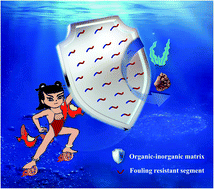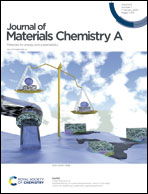Non-elastic glassy coating with fouling release and resistance abilities†
Abstract
Fouling release coatings are receiving growing attention because they are eco-friendly, where their elasticity plays a critical role in detaching biofouling. In this study, a non-elastic organic–inorganic hybrid coating is prepared by a facile sol–gel process by mixing the silane-terminated telomer of dodecafluoroheptyl methacrylate (DFMA) and poly(ethylene glycol) methyl ether methacrylate (PEGMA), triethoxyoctylsilane (KH832) with tetraethyl orthosilicate (TEOS). Such a coating with a tethered amphiphilic telomer is transparent and glassy. It also exhibits excellent adhesion to the substrate and high hardness, which can effectively prevent mechanical damage and also inhibit the rooting of fouling organisms. In particular, the coating has remarkable fouling release performance, even though it has a high modulus. This study clarifies that the low surface energy (∼20 mJ m−2) and low surface roughness (<3 nm) are responsible for the fouling release ability of the non-elastic coating. Moreover, the coating surface covered with non-leaching amphiphilic side chains can effectively inhibit the adhesion of marine bacteria, biofilms and diatoms. This robust hybrid coating with fouling release and fouling resistance ability is promising for use in anti-biofouling.



 Please wait while we load your content...
Please wait while we load your content...